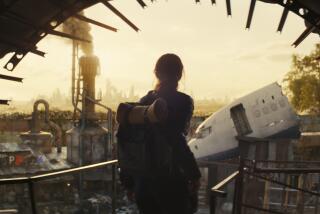BOOK REVIEW : Glare of Chernobyl Shows Other Disasters : ECOCIDE IN THE U.S.S.R.: Health and Nature Under Siege, <i> by Murray Feshbach and Alfred Friendly Jr.,</i> Basic Books, $23; 320 pages
- Share via
One measure of the magnitude of the environmental nightmare in the former Soviet Union is that from today’s vantage point, Chernobyl looks like a good thing.
While in no way downplaying the death and destruction wrought by the April, 1986, nuclear catastrophe, Murray Feshbach and Alfred Friendly Jr. explain in “Ecocide in the U.S.S.R.” that Chernobyl was only the first Soviet environmental disaster to become public knowledge. Now, with glasnost, we are beginning to understand the truly horrific extent of environmental destruction in the Soviet Union.
Chernobyl revealed more than the danger of Soviet nuclear reactors. The accident exposed weaknesses in the entire economy as well as mind-boggling inadequacies in the medical system--a system that cared more for abstract quotas than for people and in the end satisfied neither.
In the wake of Chernobyl, peoples in other parts of the former Soviet Union--from the land near the moribund Aral Sea to the shores of the perhaps salvageable Lake Baykal--rose up demanding action to halt and repair their own environmental devastation.
Six years later, in March, 1992, the much smaller accident at a nuclear reactor 60 miles from St. Petersburg was reported instantly to the world press.
We in the West are increasingly leery of the ill-designed nuclear reactors that dot eastern Europe. We are beginning to comprehend the Old Regime’s legacy of contaminated water, soil and atmospheric conditions.
Feshbach and Friendly, who document these execrable conditions in this very readable volume, are especially suited to the task. Feshbach, a professor at Georgetown, formerly advised the General Secretary of NATO; Friendly has written about the Soviet Union for Newsweek and the New York Times.
“Ecocide” offers extraordinarily rich details about Stalin’s historical mismanagement, which sacrificed millions of lives as well as millions of acres, including the Belomor Canal that Stalin ordered dug by hand in 1937. Fashioned without engineers or large machines, the canal was never deep enough to hold a boat.
So secretive were Stalin’s minions that only in 1990 were the results of the January, 1937, census published (an embarrassment to Stalin because his grand schemes had failed in their goal of spurring significant population growth).
The authors describe Magnitogorsk, an industrial city where 34% of the adults and 67% of children younger than 14 suffer respiratory diseases. Under a “shroud of pollution,” birth defects in Magnitogorsk, as in other industrial cities, have doubled since 1980.
The misbegotten medical system is, perhaps, the most shocking of Lenin’s degradations. As early as 1918, he issued a degree banishing the “bourgeois” Hippocratic Oath.
In the 1930s, the medical establishment was further corrupted by the institution of secret “medical police” whose first duty was to the state, not to the patient. But despite these institutional obstacles, many physicians held to their mission of healing and comfort.
An uphill battle lies ahead. Starting in 1970, the gap between medical promise and performance deepened. Infant mortality began to rise, and adult life expectancy began to decline.
The statistics make painful reading. Over 80% of hospitals lack hot water. Half have no sewer connections. Simple items like bandages, hypodermic needles and aspirin are not to be found.
Physicians, mostly women who are paid less than factory workers, practice without antibiotics, anesthetics or the rudiments of hygienic conveniences.
A visiting American specialist suggested that the reason so many Soviet people drink so much vodka is to deaden pain. Not psychic pain, but the pain of tooth-ache or chronic conditions treated with analgesics elsewhere in the world.
But the news is not all downbeat. Feshbach and Friendly are encouraged by a public newly able and eager to demand change.
In Latvia in 1986, public outcry stopped the construction of a new dam on the Daugava River. And the next year crowds in Irkutsk successfully protested a factory’s pollution of their river with untreated wastes.
One of the most important arguments in this very important book is a rebuttal of the notion that only rich countries can afford clean fuel and clean water.
In fact, the authors point out, poor countries that fail to clean their environment merely end up incurring tremendous expenses for sick pay for illnesses related to unclean air and water.
In the former U.S.S.R., these illnesses kept 4 million workers from their jobs each day.
A crippled giant, the former Soviet Union is still rich in resources, among which the authors would include a strong and resilient population.
The need for outside help notwithstanding, the authors are optimistic that this population, against great odds, can restore its own health and prosperity.
Next: Jonathan Kirsch reviews “Free Speech in an Open Society” by Rodney A. Smolla (Knopf).
More to Read
Sign up for Essential California
The most important California stories and recommendations in your inbox every morning.
You may occasionally receive promotional content from the Los Angeles Times.










